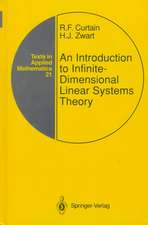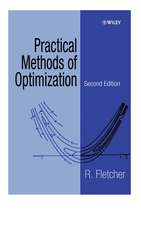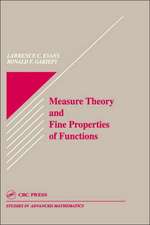Applied Mathematics: Body and Soul: Calculus in Several Dimensions
Autor Kenneth Eriksson, Donald Estep, Claes Johnsonen Limba Engleză Paperback – 30 noi 2010
The authors are leading researchers in Computational Mathematics who have written various successful books.
| Toate formatele și edițiile | Preț | Express |
|---|---|---|
| Paperback (3) | 394.29 lei 6-8 săpt. | |
| Springer Berlin, Heidelberg – 30 noi 2010 | 394.29 lei 6-8 săpt. | |
| Springer Berlin, Heidelberg – 30 noi 2010 | 398.15 lei 6-8 săpt. | |
| Springer Berlin, Heidelberg – 30 noi 2010 | 398.15 lei 6-8 săpt. | |
| Hardback (3) | 402.00 lei 6-8 săpt. | |
| Springer Berlin, Heidelberg – 17 oct 2003 | 402.00 lei 6-8 săpt. | |
| Springer Berlin, Heidelberg – 17 oct 2003 | 406.05 lei 6-8 săpt. | |
| Springer Berlin, Heidelberg – 17 oct 2003 | 472.45 lei 6-8 săpt. |
Preț: 398.15 lei
Nou
Puncte Express: 597
Preț estimativ în valută:
76.18€ • 79.54$ • 63.05£
76.18€ • 79.54$ • 63.05£
Carte tipărită la comandă
Livrare economică 04-18 aprilie
Preluare comenzi: 021 569.72.76
Specificații
ISBN-13: 9783642056604
ISBN-10: 3642056601
Pagini: 476
Ilustrații: XLIV, 426 p.
Dimensiuni: 155 x 235 x 25 mm
Greutate: 0.65 kg
Ediția:Softcover reprint of hardcover 1st ed. 2004
Editura: Springer Berlin, Heidelberg
Colecția Springer
Locul publicării:Berlin, Heidelberg, Germany
ISBN-10: 3642056601
Pagini: 476
Ilustrații: XLIV, 426 p.
Dimensiuni: 155 x 235 x 25 mm
Greutate: 0.65 kg
Ediția:Softcover reprint of hardcover 1st ed. 2004
Editura: Springer Berlin, Heidelberg
Colecția Springer
Locul publicării:Berlin, Heidelberg, Germany
Public țintă
Lower undergraduateCuprins
54. Vector-Valued Functions of Several Real Variables.- 55. Level Curves/Surfaces and the Gradient.- 56. Linearization and Stability of Initial Value Problems.- 57. Adaptive Solvers of Initial Value Problems.- 58. Lorenz and the Essence of Chaos.- 59. Optimization.- 60. The Divergence, Rotation and Laplacian.- 61. Meteorology and Coriolis Forces.- 62. Curve Integrals.- 63. Double Integrals.- 64. Surface Integrals.- 65. Multiple Integrals.- 66. Gauss' Theorem and Green's Formula in R2.- 67. Gauss' Theorem and Green's Formula in R3.- 68. Stokes' Theorem.- 69. Potential Fields.- 70. Center of Mass and Archimedes' Principle.- 71. Newton's Nightmare.- 72. Laplacian Models.- 73. Chemical Reactions.- 74. Calculus Tool Bag II.- 75. Piecewise Linears in R2 and R3.- 76. FEM for Boundary Value Problems in R2 and R3.- 77. Inverse Problems.- 78. Differential Equations Tool Bag.- 79. Applications Tool Bag.- 80. Analytic Functions.- 81. Fourier Series.- 82. Fourier Transforms.- 83. Incompressible Navier-Stokes: Quick and Easy.- 84. Fourier Analysis Tool Bag.- 85. Analytic Functions Tool Bag II.- Index.
Recenzii
From the reviews:
K. Eriksson, D. Estep, and C. Johnson
Applied Mathematics: Body and Soul
"... It would of course be ideal to combine the more rigorous aspects of mathematics with the problem solving aspects, including numerical methods. This may sound very difficult, but it is exactly what the three volume textbook Applied Mathematics: Body and Soul by K.Erikssosn, D.Estep and C.Johnson aims to do: to combine the constructive /computational (body) aspects with the symbolic (soul) aspects of mathematics in undergraduate teaching, and from my point of view the authors are largely successful in achieving their aim. I thoroughly enjoyed reading these books because they do not use the austere style in which many textbooks of mathematics are written. ...
The material is ordered in such a way that the reader/student proceeds from easier to more difficult subjects, not too differently from many other textbooks covering the same topics. There are, however, some fundamental differences. First of all, the authors try to avoid the theorem/proof structure which many mathematics textbooks use. Instead, many proofs are presented as part of a general line of thought within the main text, followed by a theorem summarizing the results. ...
Further differences with other textbooks are the use of Lipschitz continuity and Cauchy sequences (irrational numbers are for example introduced as limit of the Cauchy sequence of trancated decimal expansions), and the strong emphasis on numerical methods. This may sound surprising at first, because these concepts are usually considered to be too difficult for first year students, but the authors succeed in itnegrating these concepts very naturally into their general exposition. ...
... the books are complemented by a dedicated website which, among other things, gives students access to a mathematics laboratory with the purpose of illustrating many of the concepts introduced in the book. ..."
T.Neukirch, University of St. Andrews, Contemporary Physics 2004, Vol. 45, Issue 5
"The books are written passionately by the team of enthusiastic academicians from an interesting, nontraditional point of view. Rather than a series of textbooks for students, it is a conceptual reading reflecting an interesting educational philosophy. This exceptionally friendly and transparent exposition comprises a sufficient number of carefully selected examples explained in detail, theoretical material is generously illustrated whenever appropriate, and the reader finds numerous interesting historical insertions in the text. Furthermore, each chapter is concluded with numerous exercises at various levels of difficulty, many of these may be viewed as mini-projects stimulating independent thinking and creativity through a well-balanced synthesis of mathematics, computation and application. The project has an associated web site where additional educational materials can be found, including step-by-step instructions for independent study, problems with solutions, projects, and the Mathematics Laboratory, a collection of software which supports the theory." —Yu.V.Rogovchenko, ZENTRALBLATT MATH 1033.00010
"Mathematics Education needs to be reformed as we now pass into the new millennium", so reads the very first sentence in the preface to volume 1. But readers will be relieved to hear that this refers specifically to the field of applied mathematics (for science and engineering students) with no mention of any need to restructure mathematics curricula internationally.
The process of reform, initiated by the authors, has its roots in work that began 20 years ago in courses in computational mathematical modelling (CMM), and they say that their philosophy has "permeated through their system of basic maths education in calculus and linear algebra". The overall aim is to develop a completeprogramme for mathematics education in science and engineering up to graduate level.
Currently, the programme is under-pinned by a series of books and a variety of software, freely available online at http://www.phi.chalmers.se/bodysoul/. This website is meant to be an interactive forum for the exchange of ideas, to which students and teachers are invited to submit material for the purpose of its ongoing development. […]
As for the books, I can vouch for the excellence of the above three volumes […..]
Oh, by the way, I suggest immediate purchase of all three volumes!
Peter Ruane, MAA Online book review column (for complete review see http://www.maa.org/reviews/bodysoul.html)
"Diese drei Bände resultieren aus einem der Computerrevolution Rechnung tragenden Reformprojekt der Chalmers University of Technology mit wesentlichen Schwerpunkten in den Anwendungen, dem symbolischen und numerischen Rechnen, Modellierungen, einem konstruktiven Zugang (ermöglicht auch durch Verwendung anderer Stetig- und Differenzierbarkeitsbegriffe im Sinne von Lipschitz), unter Einbeziehung von auf Matlab basierenden Softwareprogrammen auf verschiedenen Komplexitätsstufen, mit einer eigenen Website (http: /www.phi.chalmers.se/bodysoul/), und stellen einer (laut verbreiteter Meinung seit Gödels Unvollständigkeitssatz immer größer werdenden) Trennung zwischen symbolischen und konstruktiven Zugängen zur Mathematik gegensteuemde, gelungene Synthese zwischen Theorie und Praxis dar, ergänzt durch viele schöne, aufschlußreiche Leitsätze und -motive, begleitet von vielen erhellenden historisch-philosophischen Kommentaren. ….
.Die Darstellung ist induktiv, motivierend ("Beweis-Satz", statt "Satz-Beweis"), mit stärkerem Quantitativbezug wichtiger Begriffe (was auch konstruktive "leichte" Beweise grundlegender Resultate ermöglicht), präzise und übersichtlich, anregend durch viele konkrete Beispiele aus derPraxis, Tabellen, Berechnungen, Übungsaufgaben mit Betonung auf Projektarbeit und Präsentation, vermittelt nicht nur Wissen sondern auch Können und eignet sich daher sehr gut zum Selbststudium."
H.Rindler, Monatshefte für Mathematik 144, Issue 1, 2005
"... Insgesamt aber gefällt die Konzeption von Eriksson, Estep und Johnson und sollte für jeden Lehrenden Anlass sein, die Lehrinhalte seiner Vorlesung kritisch zu hinterfragen, allen Ballast über Bord zu werfen und moderne numerische Methoden zu integrieren. Jeder Lehrende wird gewiss von einigen der in "Body and Soul" präsentierten Ideen profitieren und dadurch seine Lehrveranstaltung interessanter gestalten können."
H.-G.Roos, ZAMM, Zeitschrift für Angewandte Mathematik und Mechanik 84, No. 10-11, 772-773 (2004)
"I thoroughly enjoyed reading these books … . The three volumes cover basically every aspect of the first two years of mathematics education at university level. … The material is ordered in such a way that the reader/student proceeds from easier to more difficult subjects … . the books are complemented by a dedicated website … . recommend the books to lecturers who are looking for new ideas for their first and second year mathematics courses, and to students … ." (Dr. T. Neukirch, Contemporary Physics, Vol. 45 (5), 2004)
"The three volumes under review constitute the second part of the ambitious project aimed at developing a complete program for mathematical education of students … from basic undergraduate to beginning graduate level. … The books are written passionately … from an interesting, nontraditional point of view. This exceptionally friendly and transparent exposition comprises a sufficient number of carefully selected examples … theoretical material is generously illustrated whenever appropriate … . lovely citations … open all chapters creating a special atmosphere right from the beginning." (YuriV. Rogovchenko, Zentralblatt MATH, Vol. 1033 (8), 2004)
"I can vouch for the excellence of the … three volumes. … there is much interesting material pertaining to the history of mathematics, mainly constituted of nicely illustrated biographical descriptions of relevant mathematicians. Another distinguishing feature is the way in which the authors have successfully avoided a rigid pure/applied dichotomy and these books could certainly be recommended for maths majors generally. Concepts and techniques are rigorously worked out from first principles … . I suggest immediate purchase of all three volumes!" (Peter Ruane, MAA Online, July, 2004)
K. Eriksson, D. Estep, and C. Johnson
Applied Mathematics: Body and Soul
"... It would of course be ideal to combine the more rigorous aspects of mathematics with the problem solving aspects, including numerical methods. This may sound very difficult, but it is exactly what the three volume textbook Applied Mathematics: Body and Soul by K.Erikssosn, D.Estep and C.Johnson aims to do: to combine the constructive /computational (body) aspects with the symbolic (soul) aspects of mathematics in undergraduate teaching, and from my point of view the authors are largely successful in achieving their aim. I thoroughly enjoyed reading these books because they do not use the austere style in which many textbooks of mathematics are written. ...
The material is ordered in such a way that the reader/student proceeds from easier to more difficult subjects, not too differently from many other textbooks covering the same topics. There are, however, some fundamental differences. First of all, the authors try to avoid the theorem/proof structure which many mathematics textbooks use. Instead, many proofs are presented as part of a general line of thought within the main text, followed by a theorem summarizing the results. ...
Further differences with other textbooks are the use of Lipschitz continuity and Cauchy sequences (irrational numbers are for example introduced as limit of the Cauchy sequence of trancated decimal expansions), and the strong emphasis on numerical methods. This may sound surprising at first, because these concepts are usually considered to be too difficult for first year students, but the authors succeed in itnegrating these concepts very naturally into their general exposition. ...
... the books are complemented by a dedicated website which, among other things, gives students access to a mathematics laboratory with the purpose of illustrating many of the concepts introduced in the book. ..."
T.Neukirch, University of St. Andrews, Contemporary Physics 2004, Vol. 45, Issue 5
"The books are written passionately by the team of enthusiastic academicians from an interesting, nontraditional point of view. Rather than a series of textbooks for students, it is a conceptual reading reflecting an interesting educational philosophy. This exceptionally friendly and transparent exposition comprises a sufficient number of carefully selected examples explained in detail, theoretical material is generously illustrated whenever appropriate, and the reader finds numerous interesting historical insertions in the text. Furthermore, each chapter is concluded with numerous exercises at various levels of difficulty, many of these may be viewed as mini-projects stimulating independent thinking and creativity through a well-balanced synthesis of mathematics, computation and application. The project has an associated web site where additional educational materials can be found, including step-by-step instructions for independent study, problems with solutions, projects, and the Mathematics Laboratory, a collection of software which supports the theory." —Yu.V.Rogovchenko, ZENTRALBLATT MATH 1033.00010
"Mathematics Education needs to be reformed as we now pass into the new millennium", so reads the very first sentence in the preface to volume 1. But readers will be relieved to hear that this refers specifically to the field of applied mathematics (for science and engineering students) with no mention of any need to restructure mathematics curricula internationally.
The process of reform, initiated by the authors, has its roots in work that began 20 years ago in courses in computational mathematical modelling (CMM), and they say that their philosophy has "permeated through their system of basic maths education in calculus and linear algebra". The overall aim is to develop a completeprogramme for mathematics education in science and engineering up to graduate level.
Currently, the programme is under-pinned by a series of books and a variety of software, freely available online at http://www.phi.chalmers.se/bodysoul/. This website is meant to be an interactive forum for the exchange of ideas, to which students and teachers are invited to submit material for the purpose of its ongoing development. […]
As for the books, I can vouch for the excellence of the above three volumes […..]
Oh, by the way, I suggest immediate purchase of all three volumes!
Peter Ruane, MAA Online book review column (for complete review see http://www.maa.org/reviews/bodysoul.html)
"Diese drei Bände resultieren aus einem der Computerrevolution Rechnung tragenden Reformprojekt der Chalmers University of Technology mit wesentlichen Schwerpunkten in den Anwendungen, dem symbolischen und numerischen Rechnen, Modellierungen, einem konstruktiven Zugang (ermöglicht auch durch Verwendung anderer Stetig- und Differenzierbarkeitsbegriffe im Sinne von Lipschitz), unter Einbeziehung von auf Matlab basierenden Softwareprogrammen auf verschiedenen Komplexitätsstufen, mit einer eigenen Website (http: /www.phi.chalmers.se/bodysoul/), und stellen einer (laut verbreiteter Meinung seit Gödels Unvollständigkeitssatz immer größer werdenden) Trennung zwischen symbolischen und konstruktiven Zugängen zur Mathematik gegensteuemde, gelungene Synthese zwischen Theorie und Praxis dar, ergänzt durch viele schöne, aufschlußreiche Leitsätze und -motive, begleitet von vielen erhellenden historisch-philosophischen Kommentaren. ….
.Die Darstellung ist induktiv, motivierend ("Beweis-Satz", statt "Satz-Beweis"), mit stärkerem Quantitativbezug wichtiger Begriffe (was auch konstruktive "leichte" Beweise grundlegender Resultate ermöglicht), präzise und übersichtlich, anregend durch viele konkrete Beispiele aus derPraxis, Tabellen, Berechnungen, Übungsaufgaben mit Betonung auf Projektarbeit und Präsentation, vermittelt nicht nur Wissen sondern auch Können und eignet sich daher sehr gut zum Selbststudium."
H.Rindler, Monatshefte für Mathematik 144, Issue 1, 2005
"... Insgesamt aber gefällt die Konzeption von Eriksson, Estep und Johnson und sollte für jeden Lehrenden Anlass sein, die Lehrinhalte seiner Vorlesung kritisch zu hinterfragen, allen Ballast über Bord zu werfen und moderne numerische Methoden zu integrieren. Jeder Lehrende wird gewiss von einigen der in "Body and Soul" präsentierten Ideen profitieren und dadurch seine Lehrveranstaltung interessanter gestalten können."
H.-G.Roos, ZAMM, Zeitschrift für Angewandte Mathematik und Mechanik 84, No. 10-11, 772-773 (2004)
"I thoroughly enjoyed reading these books … . The three volumes cover basically every aspect of the first two years of mathematics education at university level. … The material is ordered in such a way that the reader/student proceeds from easier to more difficult subjects … . the books are complemented by a dedicated website … . recommend the books to lecturers who are looking for new ideas for their first and second year mathematics courses, and to students … ." (Dr. T. Neukirch, Contemporary Physics, Vol. 45 (5), 2004)
"The three volumes under review constitute the second part of the ambitious project aimed at developing a complete program for mathematical education of students … from basic undergraduate to beginning graduate level. … The books are written passionately … from an interesting, nontraditional point of view. This exceptionally friendly and transparent exposition comprises a sufficient number of carefully selected examples … theoretical material is generously illustrated whenever appropriate … . lovely citations … open all chapters creating a special atmosphere right from the beginning." (YuriV. Rogovchenko, Zentralblatt MATH, Vol. 1033 (8), 2004)
"I can vouch for the excellence of the … three volumes. … there is much interesting material pertaining to the history of mathematics, mainly constituted of nicely illustrated biographical descriptions of relevant mathematicians. Another distinguishing feature is the way in which the authors have successfully avoided a rigid pure/applied dichotomy and these books could certainly be recommended for maths majors generally. Concepts and techniques are rigorously worked out from first principles … . I suggest immediate purchase of all three volumes!" (Peter Ruane, MAA Online, July, 2004)
Caracteristici
First comprehensive beginners' course for mathematics from an applications-oriented point of view Originally arose from course developed for chemical engineering students at the prestigious Chalmers University of Technology Covers all the undergraduate mathematics in calculus, analysis, and linear algebra Presents completely a new approach to mathematics teaching integrating computation from the very beginning Has been thoroughly class-tested Can be used for students in mathematics, engineering and science Contains many sections on the historical development of computational mathematics, as well as many real applications Accompanying software with examples available via the internet Includes supplementary material: sn.pub/extras
















